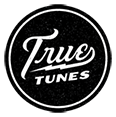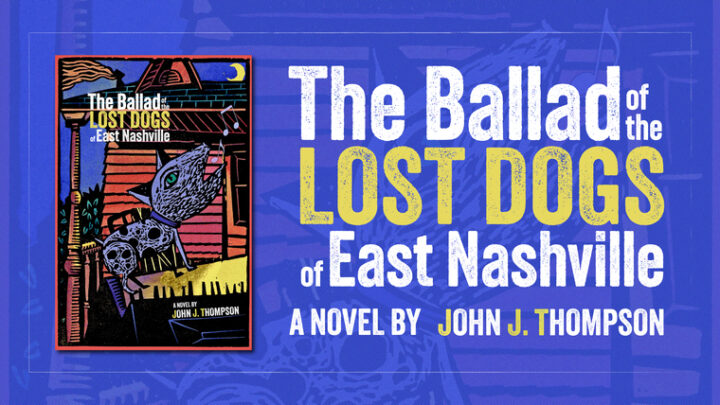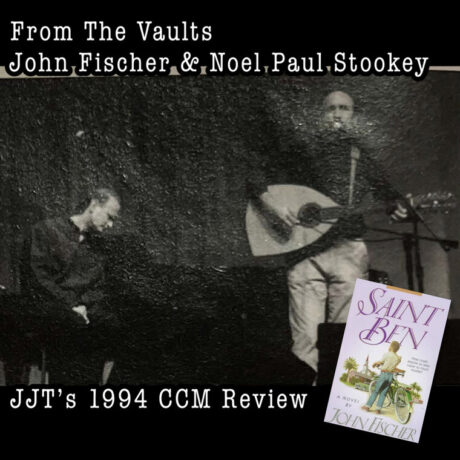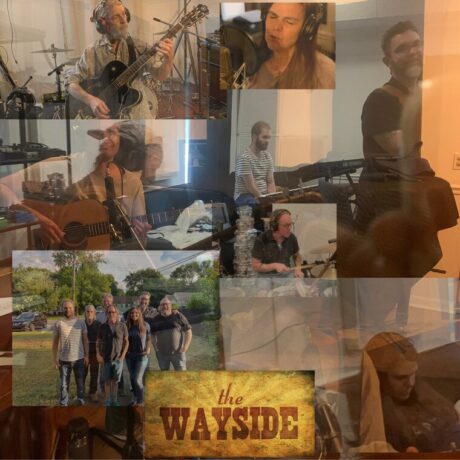Stonehill & Keaggy Go Back To Ohio
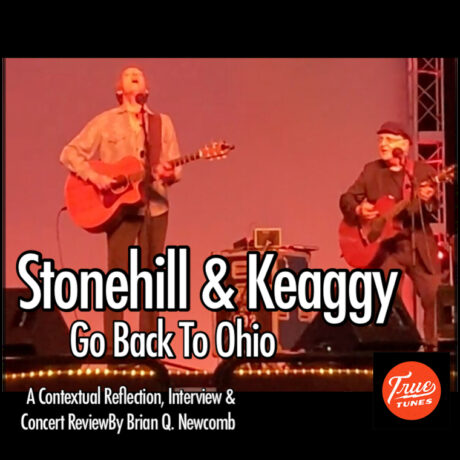
A Contextualized Refection on a 50 Year Musical Friendship and a Live Concert
by Brian Quincy Newcomb
When we heard that Phil Keaggy and Randy Stonehill would be closing out 2021 with a special co-headlined live show in Keaggy’s old stomping grounds, we knew we had to be there in one way or another. Fortunately, Brian Quincy Newcomb was able not only to cover the show for True Tunes but to talk to the artists backstage. His long history as a fan, and friend, brings a special wide-angle perspective to this particularly significant moment. If you enjoyed our recent conversation with Keaggy and Stonehill on the True Tunes Podcast, we hope you will enjoy this contextualized concert review and backstage interview by Quincy as an update.
Maybe it’s my current season in life, a month away from going on Medicare, but it seems like there’s a lot of nostalgia in the air these days. No doubt, partly from The Beatles’ three-part “Get Back” special dominating conversations among music buffs.
That monumental 50-year anniversary commemoration marker keeps showing up everywhere these days. On the religious side of the cultural divide, recent films like “The Jesus Music” and “Electric Jesus” have reminded us that we are circling around that magical five decades of life since our youth, that special time when we first heard musicians from our generation share the Gospel of God’s love made known in Jesus through music that was somewhat akin to what we were hearing on our favorite radio stations. It’s a warm, especially sentimental feeling for those of us who found in this music a way to connect our hope in the person of Jesus that we’d read about in the Gospels, with something resembling the world we experienced when we were away from the church. This music became a vital connection to our historic faith and fueled many of our salvation stories.
The first time I experienced a Christian playing what I thought of was rock music, it was Randy Matthews playing songs from his Son of Dust album in a coffeehouse (in New York?) late in 1973. Near the end of his set, Matthews mentioned that he would return for an upcoming Christian music festival just a few hours away in rural Pennsylvania the following summer. It was there, at Jesus ’74, that I first saw Larry Norman, Phil Keaggy, and Andrae Crouch & the Disciples play live, and the first and last performance of Matthews’ band. It’s hard to explain to young people today who see bands emulating the sounds of modern rock bands when they attend their church and encounter 30 minutes sets of “praise” music, that there was strong opposition from many prominent church leaders over this new style of Christian music in our lifetime. At my Christian liberal arts college that year, they devoted a week of chapel services to a book called “Rock & Roll; The Devil’s Diversion,” and TV preachers went out of their way not only to attack so-called “satanic metal” bands like Black Sabbath, but they also called Christian rock music artists “sheep in wolves clothing.” Randy Matthews came to my college to record his double-live album, alone on stage with just an acoustic guitar, the officials at Houghton College were so scandalized that they insisted he not use the school’s name in the title or disclose the location of its recording. Their secret is still safe with me.
So even with that kind of disapproval factored in, it was on that same stage that I saw early Jesus music heroes like Keaggy and his band from just down the road near Ithaca, as well as Second Chapter of Acts, Mustard Seed Faith, Paul Clark, and Randy Stonehill, whose concert I reviewed for the student newspaper, my first attempt at anything resembling music journalism. But the times they did change – soon, Amy Grant, Michael W. Smith, DC Talk, mounted major arena tours. Contemporary Christian Music, as it became known, became big business, Christian labels were bought by mainstream corporations, and the business of selling Christian pop music to church kids soon evolved into the modern worship music industrial complex we experience today.
It’s curious to me now, looking back on those formative years, how the mere mention of the names of two older musicians from that time still brings so much of that history rushing back to mind. So, I have to admit that learning that Phil Keaggy and Randy Stonehill would be playing a concert together just an hour north of my home had me immediately checking my calendar. My memory still flashes on the times I saw Phil play that old sunburst Les Paul of his, blowing my teenage mind with his virtuosity while remaining so humble and gracious. I can think of dozens of guitarists who’ve built whole careers around guitar riffs like the quick scale runs he plays just warming up during a soundcheck. And Randy too. I first interviewed him while in seminary, when the Amos & Randy tour came to Bethel College near St. Paul, MN, with Mark Heard opening. After Mark’s solo opening set, Randy did a solo set, then Daniel Amos introduced music that would make Horrendous Disc the Christian rock album to own in 1981 (until they released Alarma! a few months later). Then, for the evening’s climax, the band backed Stonehill on classic rockers like “Good News.”
So in early December 2021, I found myself driving north on the highway out of Dayton into the cornfields of Ohio, arriving at the BMI Event Center & Speedway about 15 minutes prior to my scheduled sit down with Randy & Phil to chat about their long friendship, musical collaborations, and this 50 years of what we once called “Jesus Music.” As I entered the large oval space where go-karts once raced in infinite loops, the two old friends were on stage doing soundcheck and discussing the arrangements to songs they’d written, and then rehearsing the handful of songs they would play together later that night, working on their harmonies and trying to decide if some of the high notes they used to sing were still realistic at this late date. It was agreed that we’d get together after the show, so I joined the rest of the 300+ crowd that was starting to fill up the seats in the arena.
Randy Stonehill is that rare member of the first generation of “Jesus Music” veterans who, at least prior to the pandemic shut-down, was the kind of journeyman who would climb in the car with a guitar and a box full of merch, and play shows in churches and anywhere else that would have him. Even a half-century after his debut he remains familiar to a significant audience. On this evening, Stonehill had barely started the funky open chord beat on his acoustic guitar when I heard several people near me start laughing out loud before he’d even sung a word. Now, that’s charisma, and no small amount of comic ability. In no time he had the crowd humming along to the chorus melody from “Irresistible Future,” a song he co-wrote with Keaggy for their 2009 collaboration, Mystery Highway.
Pausing only for a sip of liquid and a little throat spray, Stonehill dove into “This Old Face,” a song from his 2020 release, Lost Art of Listening, and a couple things sprang immediately to mind. First that Sir Stonehill has some serious guitar chops. Over the decades of playing solo versions of songs that were originally recorded with a full band, he’s developed a skillful approach that inserts intricate fills, and enough staccato riffage to suggest a rhythm section and even a lead guitar soloist at times. That compelling energy bouncing off the strings, together with his ever-ready left leg kick should be all the proof you need that Stonehill is a rocker at heart. While Stonehill plays his share of ballads and writes delicate melodies like the classic “King of Hearts,” he’s got serious rock chops all his own.
Next up was another track from that new album, “Beginning of the Living End,” with a lyric mentioning “bread and circus” that struck me as timely, though it relates back to Roman antiquity and was made current in philosophical conversation by no less than Dostoevsky. And then, Stonehill turned to one of his most praise-worthy compositions, the divine humanity of “Rachel Delevoryas,” a tender song about a young girl who was mocked in middle school for her looks and her love of playing the violin. This song’s gentle reminder of God’s love and care for those labeled as “outsiders,” is made all the more beautiful by the song’s plaintive musicality and Stonehill’s uniquely tasty fingerpicking embellishments. For the beloved, “Love Broke Thru,” a song Stonehill co-wrote with Keith Green and Todd Fishkind that became the title track of Keaggy’s second solo album (1976), the singer invited his wife Leslie to join him onstage to sing harmony. And then, going all the way back to the album Welcome to Paradise that introduced Stonehill to a wider audience beyond his California home, he shared the seasonal “Christmas Song for All Year Round.”
Stonehill then introduced a couple even newer, as-yet-unrecorded songs, both reflecting the stage of life when we all begin to think more about legacy, and what people will remember of our brief time surfing the mortal coil on this amazing planet we share. The first tune, “One Last Song Before I Say Goodbye,” came with the assurance that Stonehill had no intention of giving up the ghost any time too soon. Immediately, I was reminded that Stonehill is first and foremost, a very fine songwriter, and this lengthy reflection on his life’s calling and career was a case in point. In the lyrics, which were so new that he forgot them and had to double back to remember, Stonehill celebrated the “siren’s song” of “rock & roll,” and concluded that he intends to sing about “mercy and amazing grace,” and in the end, “I hope it’s love you hear.” Late in the song he acknowledged the longevity of his career, suggesting that in his “50 years,” he’s experienced both “applause” and “complaints” while performing for “cynics and the saints.” To be sure, it’s a lovely work. On that same theme, “an appointment we all will keep,” Stonehill played what I presume to be titled “On the Last Day,” another finely crafted song. Two lyrical thoughts struck close to home. In that final hour, “all that will remain is the love you could not keep inside,” and this thought about our missteps and failures, “God knew it all and loves you anyway.” Very reassuring expressions of the Gospel I have come to believe.
Then, as Stonehill has done for as long as I can remember, he played “Shut de Do’,” from the 1983 album, Equator, although a great live version appeared on the 1990 album, Until We Have Wings. To this day, Stonehill’s recorded antics from that second version show up throughout the call and response take on a faux Jamaican accent in his performances. But every time I’ve seen “Uncle Rand” perform this ludicrous attempt to “keep out de debbil,” audiences eat it up, clapping along to the song’s pseudo-reggae beat, and singing back loudly whatever Sir Stonehill throws their way. And, like that, with one final high left leg kick, the set was over. There was a brief break, with the promise that he’d join Keaggy later in the evening.
The first time I ever saw Phil Keaggy, he was traveling with a young Peter York, who played acoustic rhythm guitar which freed up the former Glass Harp lead guitarist to improvise and play solos. In the decades since that time, the technology has provided Keaggy with the ability to quickly record a rhythm part and then when it loops back around add a part on top of that, and then again, which allows a solo artist to sound like a full band. When Keaggy opened his set with “What A Day,” the bright acoustic pop song title track from his 1973 solo debut, it still sounded fresh as he quickly added the kind of melodic runs up the neck of his guitar that distinguish him as one of the best guitarists of his generation. Playing live for an audience, Keaggy smiles and engages in a way that suggests he too enjoys the music that seems to fly so effortlessly from his fingers. At one point, he sang the same notes of the melody he was playing, employing the technique often employed by jazz players, exhibiting Keaggy’s dexterity not only as musical technician, but a capacity to mix musical genres, something made all the more obvious by the 50-plus albums in his catalog.
Then, jumping forward from one of his earliest recordings, Keaggy introduced a new song, “Be Right Where You Are,” which was recorded and released as a digital download from “Keaggy’s Garage,” which is “an ever-expanding collection of live recordings and rarities from the archives” of the artist hosted on the bandcamp.com site. This song celebrated the fruit of the Spirit, suggesting that “the world would be a better place,” if Christians exhibited the qualities of love, peace, and joy. He followed that with two selctions from his 2016 release, All At Once,” the title track and “Mercy,” which again used loops. This time, Phil tapped out a solid rhythm on the wooden top of his acoustic guitar, and slid into the slinky groove of the song, playing cascades of melodic runs down the neck of his guitar, before leaning into truly smokin’ solo with precision and soul.
“Chalice,” with John Sferra of Glass Harp, was up next. The lyrics nod toward the influence of authors C.S. Lewis and Oswald Chambers, celebrating the gifts of communion, the “broken bread and poured out wine.” Here, Keaggy again layered a series of melodic loops and then brought his E-bow into play, giving the strings of his guitar the sound of being bowed like a violin. Then then pulled out “Village Bells,” honoring his upbringing in Ohio a few hours north east from the venue, from his 2019 Christmas album, The Welcome Inn. This one required a unique double capo on the neck of his guitar… a lovely song. He followed with a shout-out “to George,” and played The Beatles classic, “Here Comes the Sun,” at one point singing into the pick-up in the hole of his guitar. This no doubt blew the mind of the audience, some of whom were seeing the guitarist for the first time after hearing of his remarkable musical prowess for decades.
At this point, Keaggy gave an enthusiastic nod to the artist he was sharing the stage with, playing “Lazarus Heart,” the song he recorded for There’s a Rainbow Somewhere – The Songs of Randy Stonehill, the double disc tribute album with contributions from CCM favorites like Amy Grant and Andrew Peterson, and alternative Christian rockers like The Choir, Sixpence None the Richer, Terry Scott Taylor (producer of a handful of Stonehill’s early albums) and The Lost Dogs.
Reaching the climax of his set, Keaggy dove into a long-time concert favorite, “Salvation Army Band,” which earned some hoots from the mostly docile crowd as soon as he played the opening bassline. As he had throughout his set, Keaggy stacked looped musical lines on top of one another, tapping out the percussion, adding a bass line and then rhythm parts until he had a sturdy foundation to step toward the front of the stage and show what many in the crowd came to hear, those lightning fast runs that are as musically and emotionally satisfying as they are technically difficult. The lengthy solo was one joyously satisfying moment after the one before… and the fans responded warmly with shouts and applause. “Maker of the Universe,” from the 1986 album Way Back Home, followed suit, only it was Keaggy’s turn to forget the lyrics of one of his own songs, and a member of the crowd quickly came to his aid, yelling out the next line. Keaggy closed the set with his popular anti-abortion song, “The Little Ones.”
After another brief break, Keaggy and Stonehill returned to the stage together, and the two commenced clowning around, as we all hoped they would. Keaggy comforted Stonehill with the news that he too had forgotten the lyrics to one of his songs, “feel the bonding,” suggested Uncle Rand, before Keaggy played a bluesy rock riff and Stonehill leaped into his imitation of Elvis, singing “I feel so bad…” to which Keaggy responded singing the same line over an even bluesier riff, before acknowledging “no, I feel pretty good, actually.” Then they found their way into “That’s the Way It Goes,” a song from Stonehill’s 2002 release, Edge of the World, where live they naturally fell into the Beatlesque chorus, with Keaggy offering up his McCartney-esque harmonies to Stonehill’s Lennon-esque vocal lines, then taking a couple verses for himself, their two acoustic guitars blending as seamlessly as their voices.
They followed it with their best-known Beatlesque collaboration, recorded first recorded together in ‘87 in L.A., then reproduced in Keaggy’s Nashville studio for their wonderful full-album collaboration, Mystery Highway in 2009. Keaggy explained the long history of their work on this song; then as he had been doing off and on all evening, just let go one of those quick, scale runs up the neck of his guitar, this one particularly spicy and long – the kind of riff a guitar player would go down to the crossroads and sell their soul to be able to produce – and I shook my head in wonder at the sound of those notes, smiling as I thought, “these two should always play together, they bring the best out of each other.” Finally, they played and sang the beautiful “Sunday’s Child, which I’d easily declare one of the best songs in the ccm/Gospel music genre, joyfully hitting all the high notes, which they had warned at the beginning are “hard for someone our age to hit.”
The next song was “Who Will Save the Children,” a tender ballad reflective of both artists work to provide necessary nutrition, education, and all-around support for Third World children through Compassion Intl., embellished with encouragement from Stonehill to consider adopting a needy child. After this, Keaggy picked up his electric guitar and in seconds, was pulling long bluesy runs from the instrument, while Stonehill was vamping on the line, “I want to tell everybody,” in call and response with Keaggy’s playing, as they launched into Stonehill’s crowd favorite, “Good News.”
Then with Randy playing rhythm, Keaggy stepped out to the edge of the stage and played a lengthy guitar solo revealing why over the course of his over 50 year career as a guitarist of note he’s been a go to sideman of choice for ccm artists like Second Chapter of Acts, Paul Clark, and Michael Card, as well as metal acts like P.O.D., prog rocker Neal Morse (Kansas, Deep Purple) and drummer Jerry Gaskill (King’s X). Keaggy’s volume knob note-swell technique knowing where they had to have seen and heard it first. Keaggy’s electric technique was only on display for the 7 or 8 minutes of this song, but again, he’s a marvel to see and hear play live. Then, with Keaggy back on acoustic, they ended the night with “Mystery Highway,” a celebration of the mysterious road of life, with the promise that in the end “you only get home with love and faith.”
Backstage Conversation
After the show came my chance to sit down with the two of them and discuss their 50 year plus careers, and this stage in their lives where things are naturally slowing down, especially for Keaggy, who recently announced plans to stop extended touring. I told Phil about first seeing him at the Jesus ’74 festival, and then at Love Inn and then in college, mentioning his earlier tenure with Glass Harp. He immediately told me that his early power trio’s best album wasn’t one of their three studio albums but rather the Live at Carnegie Hall album that was recorded when the band played the famous venue. “It was so full of fire and life,” Keaggy said with a burst of pride that you don’t often see from the genuinely humble player.
When I mentioned Stonehill’s song “Good News,” also from that era, Randy recounted how he wrote the signature song on a Greyhound bus in 1970. “I was living and working at that point with the late, great Larry Norman, and eventually there were concert invitations for me. There was a guy up near Modesto, California, a town called Turlock, where my Mom had been a school teacher long before she met my Dad, and this guy had a real heart for God and for the people in his town.” He promised Stonehill a bus ticket and all his expenses to come up and play for the weekend. “I was like, 18, and I was getting traveling expenses! I think I had a few of my own songs, and I was doing things like ‘Put Your Hand in the Hand,’ and I was so excited, I was actually going to get paid for my work,” which was a year before the release of his indie debut, Born Twice. “So, I’m on this Greyhound,” says Stonehill, “and I had this long bus ride, and I was thinking about this Jesus who’d just come crashing into my life, and I wrote ‘Good News.’ I played it that weekend and five years later it ended up on Welcome to Paradise.”
When I asked about the long journey of Jesus Music into the Contemporary Christian Music business and its current dissolution, and what they make of all they’ve witnessed and experienced over these five decades, and they both broke up in laughter. Keaggy offered, “from my perspective it’s pretty simple. When I do ‘What A Day,’ or some of those old songs, it takes me back to the Jesus movement. It was the ‘first love’ stuff, that really happened to us. The Holy Spirit fell – unity, healing, illumination – our minds got free and fresh; we got delivered, we had hope.”
“I was always more of an underground artist in the ccm world,” Phil continued. “More on the periphery. But, in my heart, where Jesus lives, I feel centered, I don’t feel confused. In fact, since I stopped recording for major record labels in 2002, I’ve been happier in general. Not feeling constrained…”. Then he added “I don’t know how to market a record, never did; I don’t even know how to copyright a song and I’ve written hundreds of them. I don’t know who does that, but ‘Thank you,’ whoever does that for me.”
At that point, I thought of all the indie DIY artists who are laboring away in relative obscurity writing and recording their own music, and then figuring out publishing and copyrights, depending on crowdsourcing to front the production costs on CDs and if they’re lucky vinyl, while forced to act as their own marketing, publicity and promotions people, and still packaging and filling online orders at UPS or FedEx. As veteran recording artists with a level of built-in name recognition, both Keaggy and Stonehill benefit from promoters still inviting them to come out and perform and both of them have folk like Tom Gulotta who manages the Keaggy’s Garage recording archive at Bandcamp.com for the artist, and who was the organizer behind the Kickstarter that made the double-disc Stonehill tribute album possible. Without the clout and reputation of five decades of musicianship and notoriety, most up-‘n-coming artists aren’t going to be able to afford that level of support. The forces that gave us the Jesus Movement and the music and subculture it cultivated may have the internet, social media, and other advantages, but they also have to compete on a much more demanding playing field.
Commenting on the Keaggy’s Garage listings, Phil said, “a lot of them are live, a lot of people like the live stuff, but my favorite ones are the studio albums, that’s where I really honed what I wanted to do. Especially the albums like Lights of Madrid, and Beyond Nature, my instrumental works, I really love those a lot. The thing is, Jesus Christ is the same, yesterday, today, and forever. So if we stay close to him, we can stay centered like he is, so consistent, and the music can just flow out of us. Like tonight, it could have been 1975 for me and Randy, except for the newer songs. The audience has grown older with us, so there’s a love and a deep appreciation between us. And I’m not abandoning my audience, I want to be there for them, I just don’t want to travel so much on airplanes.”
Speaking of playing live, Stonehill has been the most active artist on the touring circuit from all of the early Jesus music veterans. He says, “up until COVID, Leslie and I used to joke about being Gypsies for Jesus. There’s a vitality about interacting with a live audience that will always be a part of my lifeblood. But it was interesting that when things did grind to a halt, we stood before the Lord, just wanting to listen and obey, asking ‘what now?’ Then we got involved with Patreon, which is a great way to stay in touch and maintain contact with your audience, your constituency. And, it was precious to me too, because instead of just visiting my home [between tour dates]… all of a sudden I was sitting in my big chair in my bathrobe and all of these new songs came pouring out. So, now, with things beginning to open up more, and with live audiences more willing to show up, Leslie and I want to continue touring. But, I echo Phil’s sentiment to, we don’t just want to be at the beck and call of the road.
“It’s a little harder on you, as you get older,” admits Keaggy. “I don’t know how Tony Bennett did it for so long. Some people just live for the stage, and then you’ve got people like Paul McCartney, you’ve got thousands of people a night wanting to come see you. How do you let them down?”
At this point, I suggest that it’s a little easier on those much higher income levels hit the road at their leisure, with several days off between shows. That’s a whole different thing than bands piling into a van with all their equipment and playing nearly every night for weeks without end. “Yeah,” admits Keaggy, “or climbing into a sardine tin with wings for a weekend of shows. It takes a bit out of us. Once Bernadette (Phil’s wife) started feeling it too, as she’s younger than me, she goes ‘let’s talk to Holly.’” He was indicating his manager Holly Benyousky, who has a long history in artist representation and booking, who worked with lots of the Solid Rock artists, Stonehill among them. Keaggy, like Stonehill, has also recently entered into a Patreon relationship with his fans.
Between Patreon and Kickstarter, Randy says, “it’s all new terrain to me, but I’m very encouraged by the response; the way it allows you to connect with people who want to hear your stuff. That very well might be the way to go forward with the next record. Leslie and I are able to do a lot of video things for our fans, just with her iPhone. So, I’m excited for guys like Phil, and people like Terry Taylor, who have their own studio gear and they’re really comfortable in that environment, they are able to do so much creative stuff, and their fans are just going to love it. For me, I’m sort of a Luddite. But we’ve been able to create a few concert like things at home.”
Turning our attention to the Stonehill tribute album, Keaggy describes how it feels to perform “Lazarus Heart.” “I love that song. When I sing that song I visualize it, and it’s like a little movie opens up. I’m on this boat with a telescope, with an island, the stars, and the angels. You’re so vivid, in your writing, Randy. And I love the rest of the album, too, by the way, I’m just blown away by some of the performances.”
“I have to say,” Stonehill adds, “I was really touched, and frankly a bit overwhelmed by the warm response we got as word started getting out about this project coming together. It started out as a 12, maybe 13 song, single CD, and it blew up into a double disc, 22 cut…
“…and they’re all your friends, too,” adds Keaggy. “They all really love you.”
“Well, thank you.. It left me kind of speechless. It reminded me of the bond of the Christian community, and it reminds me of God’s generosity and what he does with songs. People were calling up and telling us that this or that song help galvanize their spiritual vision, how it encouraged their hearts, and why they really wanted to be the one to perform it on the album. And hearing my songs, through the voice and vision of other artists gave me a whole, surprising kind of fresh take on the songs, and the strength of the songs. When I record them, or sing them myself, I’m too close to it. Of course, I try to be a good craftsman, and you ask God to breath on it, but when you hear another artist doing it, you see it through different eyes, a different filter. You go, ‘God is good, and this is some work I’m proud of.’”
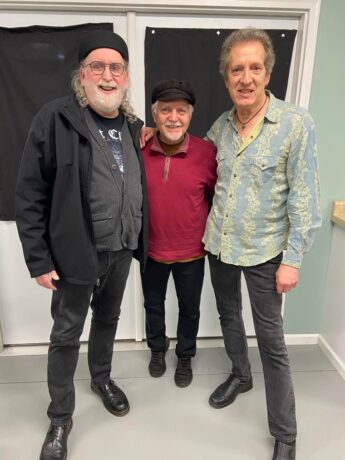
For more information about Randy Stonehill CLICK HERE
For more information about Phil Keaggy CLICK HERE
Don’t miss the incredible trove of music available in KEAGGY’S GARAGE!
Check out JJT’s review of Stonehill’s latest album LOST ART OF LISTENING – HERE!
